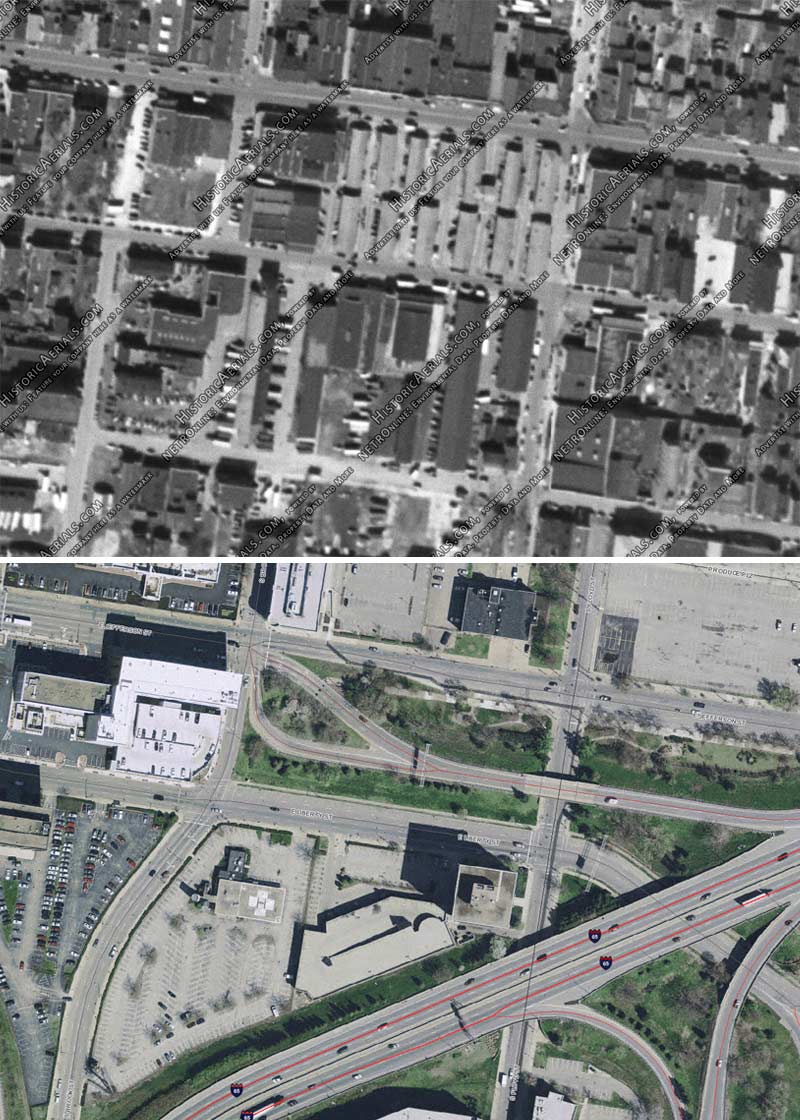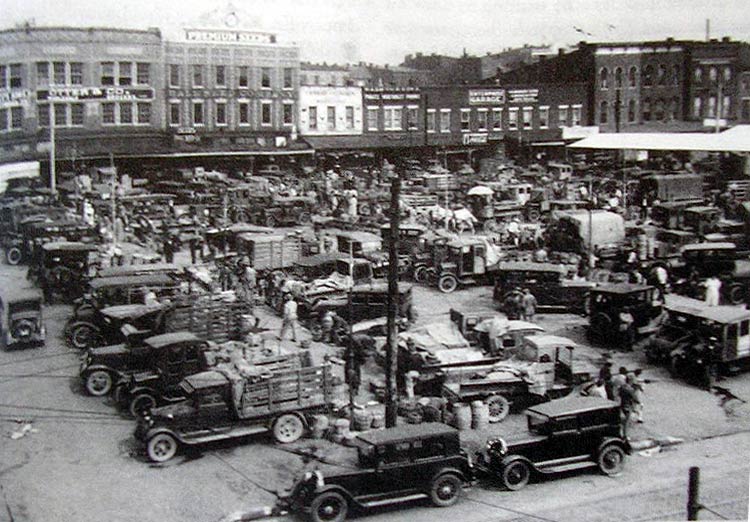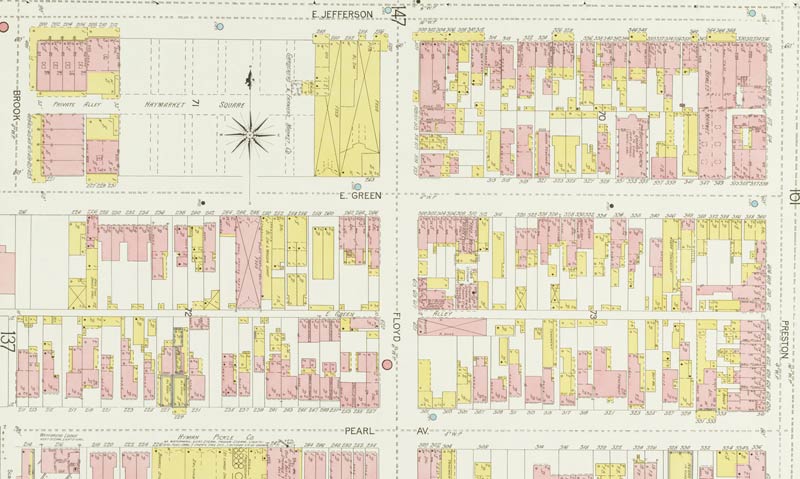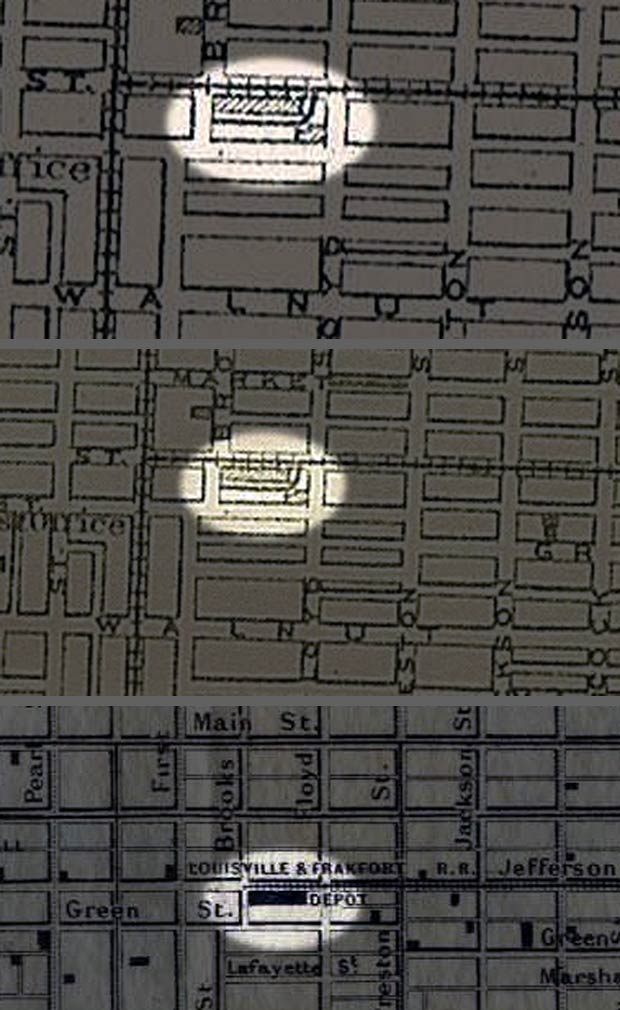The Haymarket maintains a special place in the collective conscious of Louisville’s urban life. It represents a time of intense vitality in the city’s urban core when Haymarket Square was as lively as any street the world over. While today many people regard the site of U of L’s planned Nucleus biomedical development as “the Haymarket site,” the mother of all farmers markets traces its roots across the street where an I-65 off ramp now sits.

Bounded by Jefferson, Floyd, Liberty (then named Green), and Brook streets, Haymarket Square must have been a sight to behold. Hectic, bustling, and gritty for sure, but vital to a thriving and growing city. Despite its name, according to the Encyclopedia of Louisville, the market was dominated by fruits and vegetables and not so much hay. Established in 1891 by the Gardeners and Farmers Market Company, the Haymarket
Over time, the market grew and added open sheds in the 1920s to all-weather vending. You can see in the aerial view below, the Haymarket has pushed all the way to Floyd Street and even farther to the south with a few additional sheds. Support businesses lined the perimeter. Previously, the block was occupied by the city’s first railroad depot for the Louisville & Frankfort Railroad dating to the 1850s before it relocated to First Street and River Road in 1881 (the depot can be seen on maps at the end of this article).
The market served to stock Louisville’s best restaurants and groceries, but some individual residents also could be found in the mix looking for a wholesale bargain. The operation was such a success, it spawned one of Louisville’s first districts, dubbed “Public Market Place,” bounded by Third, Jackson, Market, and Liberty streets and cart-vendors were permitted to sell their goods along the sidewalk curb.

Large chain groceries signaled the beginning of the end for the Haymarket as smaller buyers were slowly forced out of business. In 1955, the city opened the Louisville Produce Terminal outside of the core city on Jennings Lane and in 1962 was forced to close for good after 71 years to make way for the construction of Interstate 65, whose off ramp to Brook and Jefferson streets now occupied the site.
The same year, Louisville’s Urban Renewal Agency attempted to salvage what was left of the Haymarket in a new facility designed by architect Jasper Ward called Produce Plaza between Market, Preston, Jefferson, and Floyd streets. In the process, Urban Renewal bulldozed the entire block we have come to call the Haymarket site. Produce Plaza opened in 1966 and continued the tradition of selling Christmas trees, still fondly remembered across the city.
(As an aside, markets similar to the Haymarket still exist in many places, with one of the most notable being the Hunts Point Market in the Bronx, serving to stock restaurants and groceries across New York City. It’s quite an amazing operation. Anyone know if something similar still exists in Louisville?)
Though gone today, the Haymarket still represents an important part of Louisville history and another tragic example of the loss of urban vitality the city experienced over the 20th century. Take a look at the maps above and below for a comparison of what once existed with the vast destruction that ensued after World War II.
Some of the businesses that grew up with the Haymarket included Louisville’s famed shoe market described by Grady Clay and published in Jane Jacobs’ Death and Life of Great American Cities. Clay fought to save the market against destruction from Interstate 65 but reported at the time that “Nobody at City Hall seems at all concerned about it.”
Among plans for the Nucleus site, the University of Louisville has previously mentioned including a museum on the Haymarket, but it seems with the resurgence of farmers markets across the city, there could be potential for reviving the Haymarket as the city’s preeminent farmers market in the vicinity of the old “Public Market Place.” With a push during Mayor Abramson’s administration to build a permanent market house downtown and the growing foodie scene nearby in Nulu, perhaps we can renew the market as more than a memory in a museum.







Interesting. You continue to remind me that what ever I think I know about Louisville’s past is next to nothing.
I am devouring any article I come across that has anything to do with Local food economies and growing food. Planetizen and the C-J have interesting articles today, also.
I am not entirely sure where you are going with the Haymarket and Highway connection, but perhaps the Columbus OH example is relevant. North Market is a fixture in that community. It might be more of a food court now than a wholesale or farmer’s market, but still it is vibrant. I think the deli options are more prevalent now as the University and Downtown grow towards it.
There sure is a lot of non-contributing/unused “green space” in that 3D automobile environment (1st LOJIC image above). I don’t have any reason to walk along any of those streets today. Highway to (with) Haymarket?
Not completely related, but does anybody recall hearing a couple years back that there were plans for a year-round farmers market just a few blocks East of this location near the Green Building? Wonder what ever came of that?…
While researching the history of the Haymarket, did you happen to come across a lawsuit in the 1920s regarding violation of the terms of the deed transfer from the original owner to the railroad company? I have family connections to the plaintiffs.